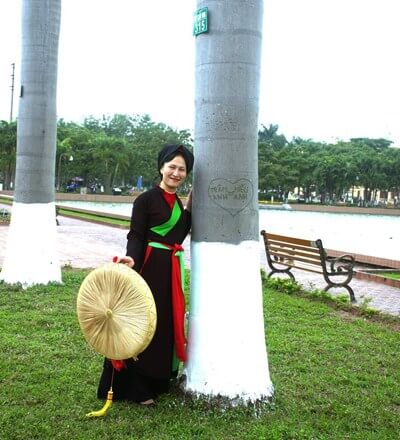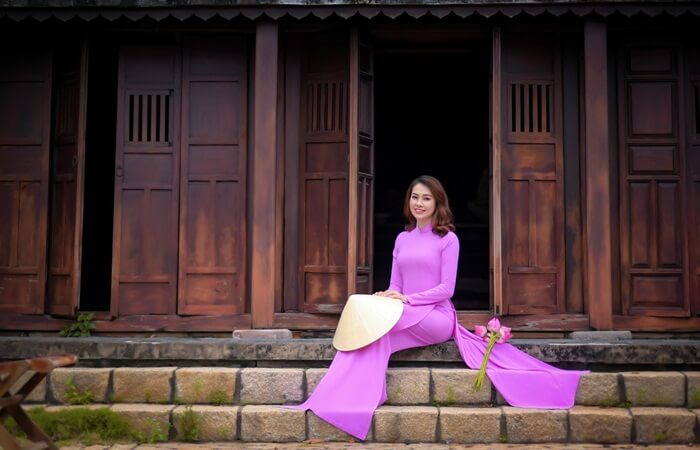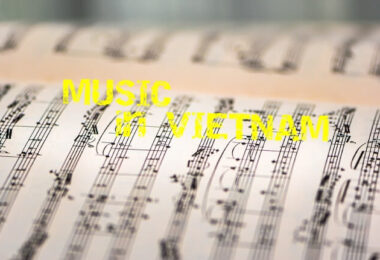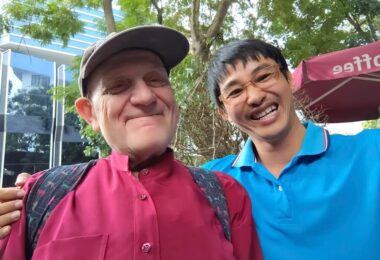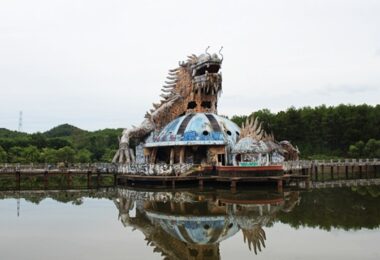Vietnamese traditional dresses are a combination of the creation of ancestors and the effects of historical upheaval and then become part of the culture.
The four-piece costume, ao dai, and ao ba ba have long been associated with the Vietnamese people and are familiar with friends in the world.
Learning about the origin and meaning of the national costume is to show appreciation for the cultural values.
The graceful four-piece dress in North Vietnam
The four-piece dress has been associated with Kinh Bac (the north) women since ancient times. They wore it in daily activities until the end of the 20th century.
Later, the four-piece costume only appeared on stage, or the Lunar New Year holidays and family worship, visiting pagoda, or Liem festivals.
Regarding the origin of the four-piece robe, so far no official record has been found in the history books. However, there are many oral stories in folklore, some people say that when Hai Ba Trung (14 – 43) fought to gain the Han troops out of our country, they wore a long dress with two sides and golden armor. It is because of the reverence for the Hai Ba Trung, the Vietnamese people do not wear the two-piece dress but use the four-piece, later called Ao Tu Than in Vietnamese.
Many people believe that, because the technology in the past was not advanced, only short silk bands were made, so they chose to put them together to wear, which creating the four-piece costume.
The four-piece dress is graceful and gentle, emphasizing the femininity of young women in Vietnam. The dress consists of 4 main parts, including a long dress with four pieces of clothing, a camisole, a belt, and a long skirt.
- The outer quadruple shirt has two long flaps, but four pieces, no buttons, sleeves, and sleeves.
- A camisole is a thin, dark blouse usually for older women or white, peach, and crimson for young girls.
The girls also delicately embroidered lotus flowers or nice motifs on their shirts. The four-piece dress is also combined with a crow-beak scarf, and a flat hat (non quay thao). This is a traditional dress in North Vietnam, that the girls wear to attend village festivals.
In the past, the four-piece dress was associated with the daily activities of a Kinh Bac girl. From working in the fields, weaving silk, raising silkworms, all associated with a camisole and a four-piece shirt that is both graceful and discreet.
Today, perhaps the image of a four-piece costume or raven-beak scarf gradually appears less and less, giving way to modern, dynamic fashion. But, somewhere in the mother’s closet, there are still some four-piece dresses that are carefully preserved, and both to be worn on important occasions and passed on to descendants about the quintessence of the ancient Vietnamese costumes.
Charming traditional dress in Central Vietnam with dreamy purple Hue ao dai
According to its origin, Ao Dai is classified as a traditional costume of the Central region. Leisure, grace and nobility are what make the Ao Dai become the national dress of Vietnam.
Referring to the Central region, it is impossible not to mention the purple ao dai of the dreamy Hue City, Vietnam.
According to the line of history, Ao Dai has been transformed through many designs.
- Starting from the appearance of the cross-collar shirt, to the round-neck shirt to the buttoned-down five-piece shirt with a straight collar.
- In the reign of Lord Nguyen Phuc Khoat in 1744, he began to order men and women in the country to wear soft long robes, pants, and scarves on special occasions.
- And next, King Minh Mang (1820-1841) in the Nguyen Dynasty issued a decree banning women from wearing skirts and forcing them to wear two-leg pants.
- Later, the Ao Dai was accepted and designed to be neat and discreet to wear in combination with pants like the shape of today’s Ao Dai.
Ao Dai consists of two main parts, the long dress, and the pants. The long dress has a traditional shape, including two pieces with 20cm over the knee, long sleeves to the wrists and a standing collar.
The piece of the shirt is the place to show the art of the designers, with images of Vietnamese dragons, lotus flowers, or delicately printed or embroidered motifs. The bottom of the pants touches the ground, usually the same material as the dress fabric.
Today, Ao Dai is the national dress of Vietnamese people to show international friends when meeting or festivals. Ao Dai appears everywhere in life, gorgeous Ao Dai in the international beauty contest, dignified Ao Dai in festivals, or innocent white ao dai of schoolgirls.
Ao Dai is the preservation of traditional features that have been combined with a modern breath with variations in the shape of the dress, sleeves, and collar. The designers have blown into it their own way.
Ao dai models with boat neck, round neck, or puffy sleeves, short sleeves, knee-length dress, etc. gradually appear to bring youthful and modern colors to the ao dai. But regardless of the shape, the Ao Dai always shows the femininity and grace of the wearer and is always the pride of the Vietnamese female people.
Rustic traditional dress of Ao Ba Ba in South Vietnam
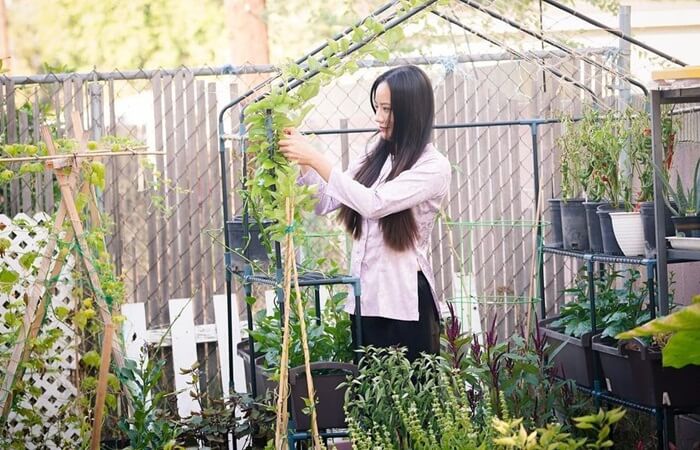
Referring to the Ba Ba shirt, we immediately think of the Mekong Delta with gentle and simple people. Ao Ba Ba is associated with the image of a heroic woman in the fight against the enemy to save the country, or farmers who work in the fields, and with young girls rowing boats on the river.
Up to now, at the same of Ao Tu Than in the north, there is no official record of the history or origin of Ao Ba Ba, but many people also tell plenty of its story. It is said that Ao Ba Ba first appeared in the South during the Later Le Dynasty (1428 – 1789), influenced by Champa costumes.
Another theory is that Ao Ba Ba appeared in the first half of the 19th century, renovated by Truong Vinh Ky (https://en.wikipedia.org/wiki/P%C3%A9trus_Ky) from the clothes of the people of Penang Island, Malaysia (Chinese Malaysians) to suit the Vietnamese people.
It is also said that Ao Ba Ba was related to the male round-neck shirt and narrow sleeves that Le Quy Don prescribed for people from Thuan Quang (in Central Vietnam) in the late 18th century.
Ao Ba Ba has long sleeves, shirt lap 20cm above the knee. It can have pockets on both sides of the flap, worn with pants, with a conical hat and a bandana, creating the typical style of South Vietnam.
In the old days, with the high class, Ao Ba Ba was often colorful, pink and blue for the young ladies or yellow and white for the ladies. For the peasant class and the common people, Ba Ba clothes were usually black or brown, suitable for daily activities to avoid getting duty.
How beautiful is the image of a girl rowing a small boat, wearing a Ba Ba shirt with a lovely conical hat! That image comes into the poems and stories in Vietnam, which makes many Vietnamese musicians and poets nostalgic.
A little rustic mixed with traditional features leftover from hundreds of years is always the way that Vietnamese traditional costumes are preserved to this day.
The traditional dress shows the most authentic evidence for the history and cultural value in the life of the Vietnamese people.
Vietnamese traditional costumes are worthy of pride and brilliant flowers adorn the general cultural picture of the Vietnamese nation.

